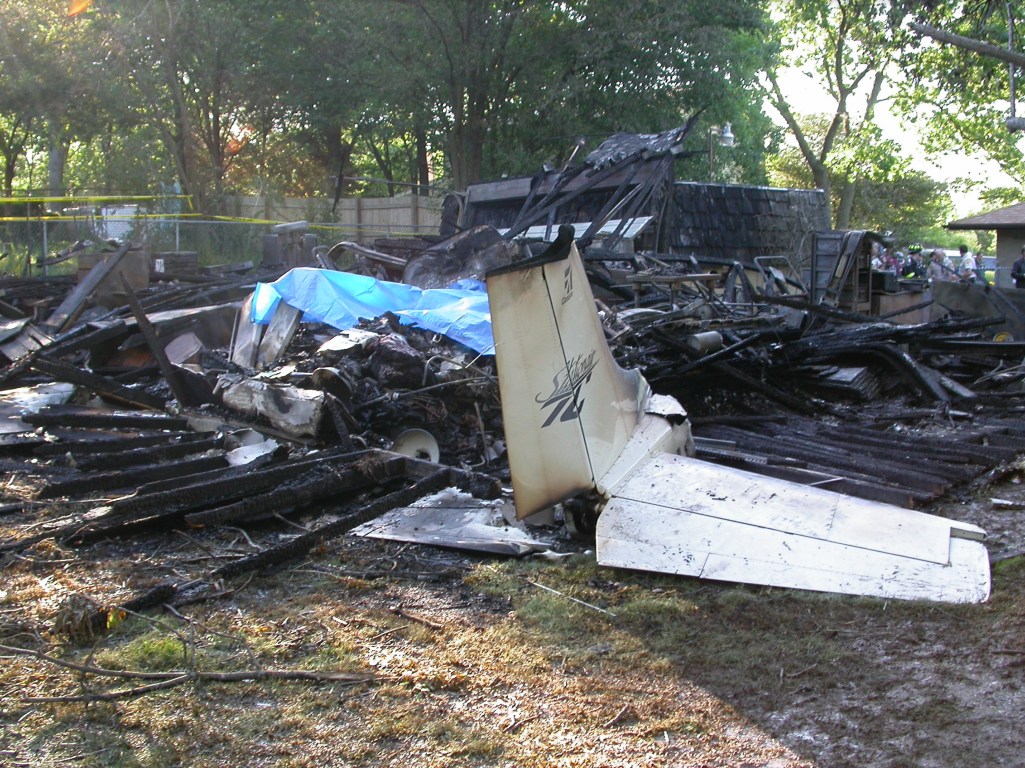
ASN Wikibase Occurrence # 44842
This information is added by users of ASN. Neither ASN nor the Flight Safety Foundation are responsible for the completeness or correctness of this information.
If you feel this information is incomplete or incorrect, you can submit corrected information.
| Date: | Friday 28 May 2004 |
| Time: | 14:30 |
| Type: | Cessna T206H Stationair TC |
| Owner/operator: | Drug Enforcement Administration |
| Registration: | N9548D |
| MSN: | T20608062 |
| Year of manufacture: | 1999 |
| Total airframe hrs: | 628 hours |
| Engine model: | Textron Lycoming TIO-540-AJ1A |
| Fatalities: | Fatalities: 1 / Occupants: 1 |
| Aircraft damage: | Destroyed |
| Category: | Accident |
| Location: | Homer Glen, IL -
 United States of America United States of America
|
| Phase: | Landing |
| Nature: | Aerial patrol |
| Departure airport: | Chicago-Midway Airport, IL (MDW/KMDW) |
| Saint Louis-Spirit of St. Louis Airport, MO (SUS/KSUS) | |
| Investigating agency: | NTSB |
| Confidence Rating: |
On May 28, 2004, at 1430 central daylight time, a Cessna T206H, N9548D, operated by the Drug Enforcement Administration, was destroyed on impact with a detached garage belonging to a single-family home in Homer Glen, Illinois. The pilot reported a loss of engine power to air traffic control during cruise flight. Visual meteorological conditions (VMC) prevailed at the time of the accident. The Title 14 Code of Federal Regulations (CFR) Part 91 flight was operating without a flight plan. The commercial pilot was fatally injured. The positioning flight originated from Chicago Midway International Airport (MDW), Chicago, Illinois, at 1423, and was en route to Spirit of St. Louis Airport (SUS), Chesterfield, Missouri.
The 1999 Cessna T206H was operated as a public aircraft when the pilot reported a loss of engine power during cruise flight about 1,150 feet above ground level. Spectrum analysis of air traffic control transmissions indicate that a propeller speed of 1,669 revolutions per minute was present following the loss of engine power. Visual meteorological conditions prevailed with recorded surface winds from the northeast. Witnesses reported that they heard several attempted engine restarts while the airplane was being positioned for a forced landing on a 500-foot long fallow agricultural field north of a house. A witness reported that black smoke would emanate from the airplane during each start attempt. The airplane's wing and horizontal stabilizer contacted trees near the house resulting in a steep descent into the garage adjacent to the house. A post crash fire/explosion then ensued. The Airframe & Powerplant Mechanics Handbook states that a mixture "too rich" is indicated by black smoke. Examination of the airplane systems and related components revealed that the turbocharger could not be rotated and a hydraulic press was utilized to effect the removal of the turbocharger turbine wheel. The engine crankcase halves exhibited fretting, and the nut of one crankcase thru-bolt was not in place. Maintenance records indicate that the crankshaft was replaced in response to airworthiness directives and service bulletins. No other anomalies that would have precluded normal operation were found. In 1994, the National Transportation Safety Board issued recommendation A-94-081 relating to emergency procedures for turbocharger failures to be included in airplane pilot operating handbooks (POHs) and airplane flight manuals. The Cessna T206H POH does not list emergency procedures for turbocharger failures. The Cessna T206H POH states, under emergency procedures, to advance the mixture control to the rich position if restart does not occur. The manufacturer's airplane pilot safety supplement, which was reissued in 1998 to incorporate turbocharger failures, states that "If a turbocharger failure results in a loss of power, it may be further complicated by an overly rich mixture." A review of the emergency exit procedures in Cessna 206 models shows that with the flaps lowered, the forward portion of the cargo door can only be opened approximately 4 inches to allow the aft portion of the cargo door to be opened during emergency egress. The distance between the cabin roof and seat back was measured to be approximately 11 inches.
Probable Cause: The seized turbocharger, the altitude/clearance not maintained/obtained during approach to a forced landing on an agricultural field, and the unsuitable landing area encountered by the pilot. Contributing factors were the inadequate emergency procedures by the manufacturer, the trees, and the residential area.
Accident investigation:
 |
|
Sources:
NTSB: https://www.ntsb.gov/_layouts/ntsb.aviation/brief.aspx?ev_id=20040608X00756&key=1
Location
Images:



Photos: NTSB
Revision history:
| Date/time | Contributor | Updates |
|---|---|---|
| 28-Oct-2008 00:45 | ASN archive | Added |
| 21-Dec-2016 19:24 | ASN Update Bot | Updated [Time, Damage, Category, Investigating agency] |
| 07-Dec-2017 17:58 | ASN Update Bot | Updated [Nature, Source, Narrative] |
Corrections or additions? ... Edit this accident description
The Aviation Safety Network is an exclusive service provided by:


 ©2024 Flight Safety Foundation
©2024 Flight Safety Foundation